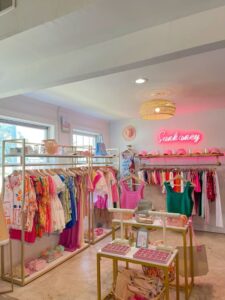
Keeping Up with Trends: How Small and Big Retailers Can Tackle the Challenge
In today’s dynamic retail landscape, keeping up with retail trends is essential to stay competitive and relevant. Both small boutiques and large retail chains must stay on top of evolving consumer preferences, technological advancements, and market shifts to capture and maintain customer interest. However, this challenge comes with a variety of hurdles that often vary in scope depending on the retailer’s size. For small retailers, limited resources may hinder quick adaptations, while for large corporations, bureaucratic red tape can slow down the ability to pivot. Regardless of size, retailers who succeed in trend adaptation are the ones who engage with their customers, invest in data, and foster flexibility.
In this article, we’ll discuss why keeping up with trends can be so challenging, break down the common struggles faced by both small and big retailers, and offer retail trend strategies to help them not only keep pace with trends but also anticipate and capitalize on them.
Why Keeping Up with Trends Is Challenging
The pressure to stay ahead of trends stems from the need to capture customer interest continually. In the age of social media and rapid information sharing, trends evolve quickly, and customers expect retailers to keep up. Here are some reasons why this task proves challenging for many retailers:
Constantly Shifting Consumer Preferences: Consumer preferences fluctuate rapidly, influenced by global events, influencer marketing, and even viral social media content. Trends like sustainability, personalization, and experiential retail rise and fall, leaving retailers scrambling to keep up.
Data Overload: Retailers today have access to more data than ever, but the challenge lies in interpreting and acting on it. For small businesses, accessing affordable tools to analyze data can be difficult. Larger companies, on the other hand, may have data analysis capabilities but face internal roadblocks when it comes to decision-making.
Supply Chain Constraints: With trends changing fast, aligning inventory with demand is tough. For example, a trend can peak during production, leading to an oversupply or undersupply situation that affects sales and profit.
Increased Competition: The rise of digital platforms and the accessibility of e-commerce have intensified competition. Small retailers often feel overshadowed by larger brands, while big retailers struggle to compete with agile e-commerce businesses that can adapt to trends almost instantly.
Limited Resources: Keeping up with trends requires investment in research, product design, and marketing. Small retailers often struggle with budget constraints, while large corporations face difficulties in allocating resources quickly across large-scale operations.
Challenges for Small Retailers
Small retailers, in particular, face unique challenges when it comes to keeping up with retail trends. Limited budgets, smaller teams, and a narrower reach can make it difficult to compete with larger players. Here’s a closer look at some of these issues:
Limited Marketing Budgets: Smaller retailers often lack the resources for extensive trend research or marketing campaigns, limiting their ability to launch new products in line with current trends.
Fewer Tools for Data Analysis: Access to advanced data tools can be prohibitively expensive for small businesses, making it hard to monitor customer preferences and spot trends early.
Resource Constraints for Trend Testing: Trying out new trends can be a financial risk, especially if demand doesn’t meet expectations. Small retailers are often cautious about investing in trendy products, fearing losses if trends fizzle out.
Challenges for Large Retailers
While large retailers benefit from economies of scale and resources, they also face their own set of challenges in staying trend-relevant:
Complex Decision-Making Processes: Larger organizations often have more layers of approval and bureaucratic processes, slowing down their ability to respond quickly to trends.
Difficulty in Maintaining Brand Consistency: With so many departments involved in trend adoption, there’s a risk that the brand’s core identity may be diluted or inconsistencies may arise.
Logistics and Inventory Management: Managing inventory across multiple locations is a logistical challenge. Big retailers may find it difficult to balance inventory levels with rapidly changing trends, especially in fast-moving sectors like fashion.
Solutions for Staying Ahead of Trends
For retailers ready to take on the challenge of how to keep up with retail trends, the following strategies can help both small and large businesses stay competitive:
1. Monitor Industry Trends and Customer Preferences
To keep up with trends, it’s essential to stay in touch with industry developments. Subscribe to industry newsletters, follow trade publications, and keep an eye on social media trends. Use Google Trends to see what consumers are searching for and consult platforms like Retail Dive for up-to-date industry insights.
2. Engage with Customers Directly
Listening to your customers is crucial for spotting trends early. Conduct surveys, gather feedback on social media, and pay attention to product reviews. Small retailers can leverage close customer relationships to get insights, while big retailers can use segmentation to target trend-focused surveys.
3. Utilize Data Analytics
Investing in data analytics tools can be a game-changer. Tools like Google Analytics, CRM software, and social listening platforms provide invaluable insights. Larger retailers can use AI-driven analytics for a predictive look at trends, while small retailers can leverage free tools to identify patterns in customer behavior.
4. Implement Flexible Inventory Practices
For small retailers, a test-and-scale approach is ideal. Start with small orders of trendy items and increase quantities based on demand. Large retailers can benefit from “just-in-time” inventory systems to avoid overstock and maintain flexibility.
5. Create a Brand Community to Capture Trends Early
One of the most effective ways to spot emerging trends is to have a community of loyal customers. Building a strong brand community can keep your customers engaged and allow them to share their thoughts on upcoming trends. Social media platforms like Instagram and Facebook are ideal for creating interactive posts, while loyalty programs can encourage customers to share insights.
6. Collaborate with Influencers
Influencers often have a pulse on what’s popular, making them valuable partners in trend awareness. For small businesses, partnering with micro-influencers is a cost-effective way to stay relevant. Big retailers, on the other hand, can collaborate with industry leaders to spotlight emerging trends on a larger scale.
7. Use Competitor Analysis
Keep an eye on competitors, both big and small. Track what they’re promoting, the products they launch, and how they’re positioning themselves in the market. This insight can help you make informed decisions on whether to adopt similar trends or carve out a unique approach.
The Benefits of Staying Trend-Forward
Retailers who master trend adaptation not only meet customer expectations but also strengthen their brand, build loyalty, and stand out from competitors. For small retailers, staying trend-forward can mean differentiating themselves from competitors. For large retailers, it reinforces their market dominance and allows them to reach wider audiences.
In conclusion, staying on top of trends is essential for survival and growth in the retail world. With these strategies, retailers of all sizes can confidently navigate the challenges of trend adaptation, ensuring they remain relevant and successful in an ever-evolving marketplace.




